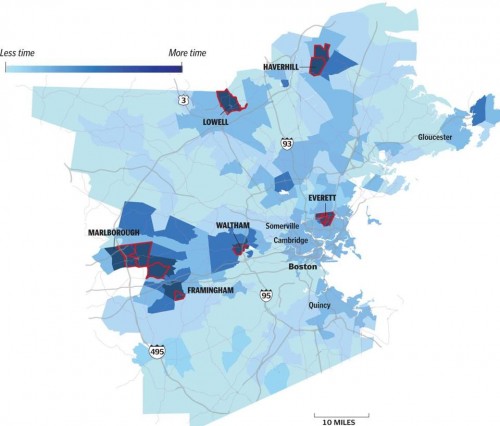Now We Know Who To Blame For All That Traffic
Written by Boston Biker on Feb 18
The dark blue on the map shows the neighborhoods whose residents spend the most time stuck in traffic. The red outlines identify 15 census tracts whose drivers disproportionately clog traffic, because they all tend to travel on the same small number of roads at the same time. When commuters from these census tracts clog the roads, the congestion ripples throughout the entire metro area, making everyone’s commutes longer.
A recent study by MIT and UC Berkely using anonymous cell phone data and gps have determined that it is just 15 areas in the Boston metro area (out of 750 tracked by the census) are causing almost all of the traffic jams in Boston.
What they found, perhaps surprisingly, is that during rush hour, 98 percent of roads in the Boston area were in fact below traffic capacity, while just 2 percent of roads had more cars on them than they could handle. These congested roads included short stretches of I-495 southbound and Route 128 southbound, a number of downtown streets, and a wide scattering of suburban arteries, such as Bridge Street in Lowell (southbound) and Water Street in Haverhill (northbound). Each of these roads has what the engineers term a high degree of “betweenness”—that is, they’re essential for connecting one part of the metropolitan area to the others.
The backups on these roads ripple outward, causing traffic to snarl across the Hub. Marta Gonzalez of MIT, one of the lead engineers on the study, explains the effect this way. “The analogy we make is of your circulatory system,” she says. “When you have one artery that is blocked, it will affect your entire circulation.”
By tracking the cell records, they found that it’s just a small number of drivers from a small number of neighborhoods who are responsible for tying up the key roads. Specifically, they identified 15 census tracts (out of the 750 in Greater Boston) located in Everett, Marlborough, Lawrence, Lowell, and Waltham as the heart of the problem, because drivers from those areas make particularly intensive use of the problematic roads in the system.(via)
What this says to me is that, if we could connect these areas to decent public transportation and cycling options we could eliminate large amounts of traffic in this town. By working smarter, not harder, we could burst the bubble of traffic with laser guided improvements to our infrastructure.
The study demonstrated that “canceling or delaying the trips of 1 percent of all drivers across a road network would reduce delays caused by congestion by only about 3 percent,” MIT wrote. ” But canceling the trips of 1 percent of drivers from carefully selected neighborhoods would reduce the extra travel time for all other drivers in a metropolitan area by as much as 18 percent.”
The effectiveness of this “selective strategy” is attributed in the study to the facts that “only [a] few road segments are congested” and that these road segments are clogged by people originating largely from only a few areas. Even though data was anonymous, researchers were able to infer drivers’ home neighborhoods “from the regularity of the route traveled and from the locations of cell towers that handled calls made between 9 p.m. and 6 a.m,” UC-Berkeley said.(via)
If we can get drivers in these targeted areas to bus/train/cycle to work, we could dramatically reduce traffic in the rest of the town. Combined with some sort of congestion tax to keep otherwise non-car drivers from filling in the empty space made by the reduction of traffic, and using the money from that and a re-organized tax system to fund improvements in public transportation infrastructure, we could be living in a very pleasant city devoid of most single occupancy car drivers.
Science!
Tags: cars, MIT, science, traffic
Posted in advocacy, Commuting | 6 Comments »




Sorry, comments for this entry are closed at this time.